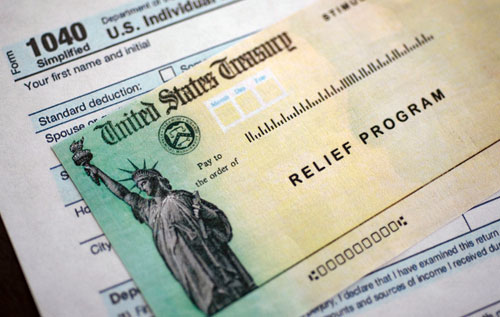 Nearly one year after the COIVD-19 pandemic-driven shut-downs began the shutter the economy, Democrats pushed through another $1.9 trillion stimulus package by narrow margins, with the President set to sign the bill. The legislation is one of President Biden’s first major achievements and contains numerous provisions that impact millions of Americans. Below we’ll look at what’s inside the legislation.
Nearly one year after the COIVD-19 pandemic-driven shut-downs began the shutter the economy, Democrats pushed through another $1.9 trillion stimulus package by narrow margins, with the President set to sign the bill. The legislation is one of President Biden’s first major achievements and contains numerous provisions that impact millions of Americans. Below we’ll look at what’s inside the legislation.
Stimulus Checks
$1,400 stimulus checks are the hallmark of the legislation, but not everyone is eligible. Similar to previous stimulus packages, single taxpayers making $75,000 or less are eligible for the full amount, but the payout completely phases-out once income reaches $80,000. Married couples earning up to $150,000 will receive $2,800, but phase-out once they reach $160,000. These income-based eligibility phase-outs are much more narrow than previous packages. Taxpayers also receive an additional $1,400 per qualifying dependent, which may include college students, disabled adults, and elderly parents.
Unemployment Benefit Extension
The weekly unemployment supplement of $300 is extended through September 6th, whereas previously, the benefit was set to expire in March. Initially, House Democrats tried to increase the unemployment supplement to $400 per week, but this change didn’t make it into the final legislation.
Child Tax Credits
Previous stimulus packages increased the child tax credit from $2,000 up to $3,000 per child, including a bonus of $600 for children six years old and younger, and made the credit refundable. Making the credit refundable expanded the benefit to millions of low-income families who previously didn’t earn enough to pay enough taxes to take the full credit.
This bill extended these provisions for an additional year through 2021, with some lawmakers looking to make the changes permanent.
Money for State and Local Governments, Schools, Vaccine Distribution, and Others
Money is allocated to help fight the pandemic's spread and impact, with $7.5 billion earmarked to fund vaccine distribution and $48 billion set aside for contact-tracing and testing efforts. Meanwhile, state and local governments have a fund of $350 billion in aid to help them cover budget shortfalls caused by the pandemic. Schools and universities received a pot of $160 billion for similar operational budget support.
Other economic assistance programs in the legislation include $22 billion for rental assistance, $39 billion for child care, $29 billion for the restaurant industry.
What Didn’t Make it Into the Bill
Initially, Democrats tried to make a $15 per hour minimum wage part of the bill; however, this didn’t make it into the final version. In order to pass the stimulus package, Democrats used a political process call reconciliation, which enabled them to skirt the 60-vote filibuster threshold in the Senate and pass it with a simple majority. However, this maneuver also limited what they could put in the bill.
Multi-employer Pension Plans
Nearly $86 billion is put into a new program, allowing the Pension Benefit Guaranty Corporation to provide assistance to beleaguered multi-employer pension plans. The aim is to ensure retirees continue to receive their pension benefits.
Conclusion and Economic Impact
The bill's stimulus impact is expected to set the US economy off and running at the fastest growth rate in more than 40 years. The economy is expected to grow 5.95 percent compared to 4.0 percent in the fourth quarter of last year, with increased employment and rising inflation.